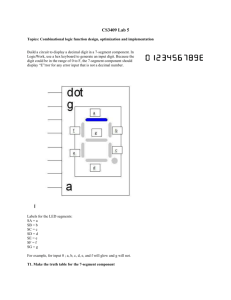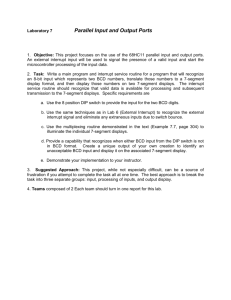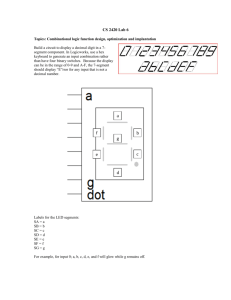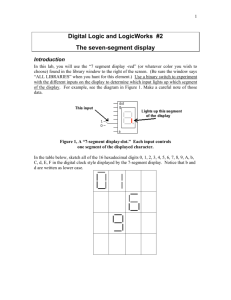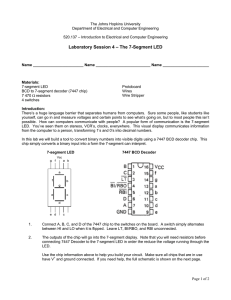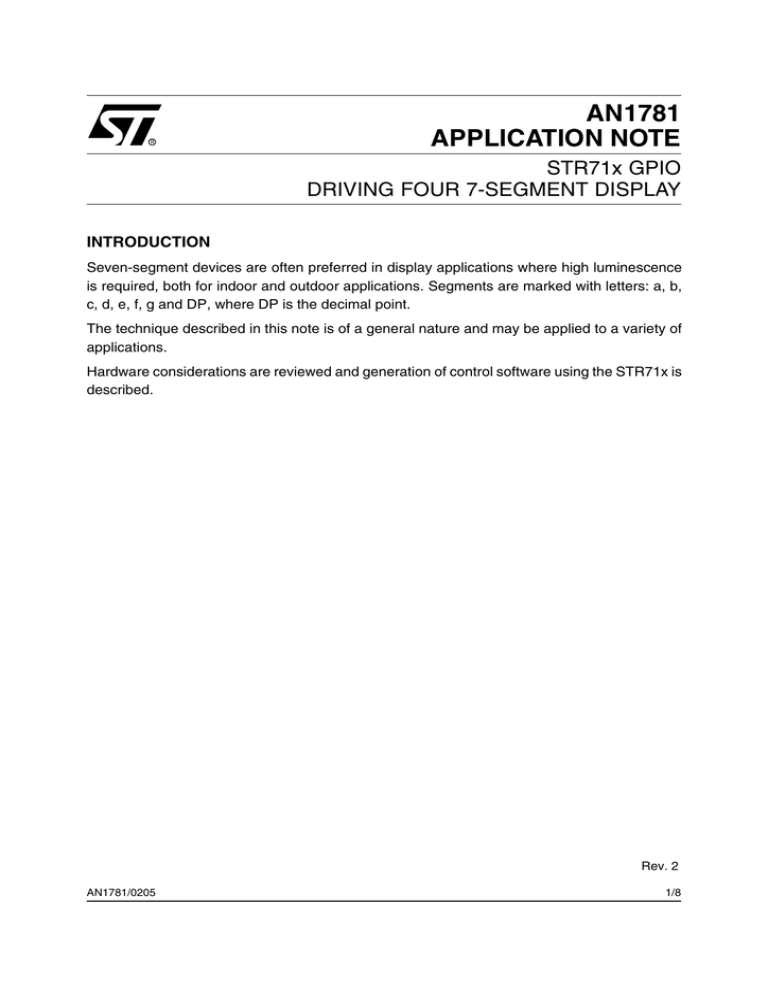
AN1781
APPLICATION NOTE
STR71x GPIO
DRIVING FOUR 7-SEGMENT DISPLAY
INTRODUCTION
Seven-segment devices are often preferred in display applications where high luminescence
is required, both for indoor and outdoor applications. Segments are marked with letters: a, b,
c, d, e, f, g and DP, where DP is the decimal point.
The technique described in this note is of a general nature and may be applied to a variety of
applications.
Hardware considerations are reviewed and generation of control software using the STR71x is
described.
Rev. 2
AN1781/0205
1/8
1
STR71x GPIO DRIVING FOUR 7-SEGMENT DISPLAY
1 PRINCIPLE OF OPERATION
A 7-segment display consists of 7 LED’s arranged in a figure-eight pattern, then by selectively
powering-on various combinations of segments, alphanumeric characters may be displayed;
a further LED is present which, when powered-on, causes a dot or decimal point to be displayed (Figure 1). The LED display can be driven by a common cathode or common anode.
With a common cathode display, the common cathode must be connected to the 0V rail and
the LEDs are turned on with a logic one.
Table 1 illustrates the required segment patterns for each numeric representation, including
the optional decimal point.
Figure 1. Structure of a 7-segment display
a
f
b
g
e
c
d
2/8
2
DP
STR71x GPIO DRIVING FOUR 7-SEGMENT DISPLAY
Table 1. LEDs turned on for a given digit
a
b
c
d
e
f
g
DP
Hex
0
1
1
1
1
1
1
0
x
0x3F
1
0
1
1
0
0
0
0
x
0x06
2
1
1
0
1
1
0
1
x
0x5B
3
1
1
1
1
0
0
1
x
0x4F
4
0
1
1
0
0
1
1
x
0x66
5
1
0
1
1
0
1
1
x
0x6D
6
1
0
1
1
1
1
1
x
0x7D
7
1
1
1
0
0
0
0
x
0x07
8
1
1
1
1
1
1
1
x
0x7F
9
1
1
1
1
0
1
1
x
0x6F
A
1
1
1
1
0
1
1
x
0x77
B
0
1
1
1
1
0
1
x
0x7C
C
1
0
0
1
1
1
0
x
0x39
D
0
1
1
1
1
0
1
x
0x5E
E
1
0
0
1
1
1
1
x
0x79
F
1
0
0
0
1
1
1
x
0x71
DP
x
x
x
x
x
x
x
1
x = Don’t care
3/8
STR71x GPIO DRIVING FOUR 7-SEGMENT DISPLAY
2 MULTIPLEXING FOUR 7-SEGMENT LED DISPLAYS
2.1 HARDWARE LAYOUT
Biasing is achieved using the STR71x I/O lines. Eight lines (P1.0 - 7) are assigned to LED segments a - g and the DP. Four lines (P1.8 - 11) are used to drive and select the 7-segment displays through sink transistors (Figure 2).
Figure 2. Multiplexing four 7-segments displays
STR71x
4 x 7-segment displays
P1.0
P1.1
P1.2
P1.3
P1.4
P1.5
P1.6
P1.7
a
b
c
d
e
f
g
DP
0.33K
0.33K
0.33K
0.33K
1.2K
P1.8
P1.9
P1.10
P1.11
BC 547C
1.2K
1.2K
1.2K
BC 547C
BC 547C
BC 547C
2.2 SOFTWARE IMPLEMENTATION
Biasing can be either continuous or multiplexed as long as the refresh frequency is high
enough to ensure image persistence for the human eye (at least 25 cycles per second to avoid
flicker) and it will appear that all the displays are turned on at the same time. As each display
is turned on, the appropriate information must be delivered to it so that it will give the correct
reading.
The multiplexing is achieved by turning on each display for 5 ms duration every 20 ms. This
gives an update rate of 50 Hz. The 5 ms time-base can be generated using a timer overflow interrupt.
The main program uses a global pointer which refers to the variable to display. The lower 4
bits correspond to the least significant digit, the next 4 bits correspond to the second digit and
so on.
4/8
STR71x GPIO DRIVING FOUR 7-SEGMENT DISPLAY
Depending on which display is selected, and using a Hexadecimal to 7-segment display correspondence table, the corresponding 4 bits are extracted, then decoded to a 7-segment display and finally sent to the 7-segment LED display.
The C code given below is for guidance only. The file cannot be used alone, the complete software can be found at http://www.st.com/mcu
#include "71x_lib.h"
const u8 b7SegmentTable[16] = {0x3F,
0x06, /* 1 */
0x5B, /* 2 */
0x4F, /* 3 */
0x66, /* 4 */
0x6D, /* 5 */
0x7D, /* 6 */
0x07, /* 7 */
0x7F, /* 8 */
0x6F, /* 9 */
0x77, /* A */
0x7C, /* B */
0x39, /* C */
0x5E, /* D */
0x79, /* E */
0x71
/* F */
};
/* 0 */
/* Pointer to the variable to display */
u16 *pCharToDisplay;
/* DP to display */
u8 bDP;
int main(void)
{
#ifdef DEBUG
debug();
#endif
/* Set system clock to 32 MHz-------------------------------------------------------*/
/* Configure the PLL with a multiplication factor = 16 and division factor = 4 */
RCCU_PLL1Config(RCCU_Mul_16, RCCU_Div_4);
/* Set the APB2 clock to default */
RCCU_PCLKConfig(RCCU_DEFAULT);
/* Set the RCLK to the PLL output */
RCCU_RCLKSourceConfig(RCCU_PLL1_Output);
/* EIC configuration -------------------------------------------------------------- */
/* Set the Timer 0 IRQ channel priority to 1 */
5/8
STR71x GPIO DRIVING FOUR 7-SEGMENT DISPLAY
EIC_IRQChannelPriorityConfig(T0TIMI_IRQChannel, 1);
/* Enable the Timer 0 IRQ channel interrupts */
EIC_IRQChannelConfig(T0TIMI_IRQChannel, ENABLE);
/* Enable IRQ interrupts */
EIC_IRQConfig(ENABLE);
/* GPIO 1 configuration ----------------------------------------------------------- */
/* Configure the GPIO 1 port to output Puch-Pull */
GPIO_Config(GPIO1, 0xFFFF, GPIO_OUT_PP);
/* Disable all 7-segment displays */
GPIO_WordWrite(GPIO1, 0);
/* TIM0 configuration ------------------------------------------------------------- */
/* Configure the Prescaler to 0x02 to get an Overflow interrupt every 5.120 ms
This will gives an update rate of 48.8 Hz*/
/* Inisialize the Timer 0 */
TIM_Init(TIM0);
/* Configure the Timer 0 prescaler */
TIM_PrescalerConfig(TIM0, 0x02);
/* Enable the Overflow Interrupt */
TIM_ITConfig(TIM0, TIM_TO_IT, ENABLE);
/* Start the TIM0 Counter */
TIM_CounterConfig(TIM0, TIM_START);
/* Configure the real time clock */
RTC_PrescalerConfig(0x8000);
/* Get the RTC->CNTL register address */
pCharToDisplay = (u16 *)RTC->CNTL;
/* Enable the third DP */
bDP = 0x04;
/* infinite loop */
while(1);
}
/*******************************************************************************
* Function Name : T0TIMI_IRQHandler
* Description : This function handles the Timer0 global interrupt.
* Input
: None
* Output
: None
* Return
: None
*******************************************************************************/
void T0TIMI_IRQHandler(void)
{
/* Holds the number of the selected 7 -segment display.*/
static u8 Displayer = 0x00;
6/8
STR71x GPIO DRIVING FOUR 7-SEGMENT DISPLAY
/* Clear Timer 0 Overflow flag */
TIM_FlagClear ( TIM0 , TIM_TOF );
/* Turn Off all 7-segment LED displays */
GPIO1->PD = 0x0000;
/* Send the next digit */
GPIO_ByteWrite(GPIO1, GPIO_LSB, b7SegmentTable[(*pCharToDisplay>>(Displayer*4))&0x000F]);
/* Drive the DP of the selected display */
GPIO_BitWrite(GPIO1, 7, bDP>>Displayer);
/* Turn on the selected 7-segment display */
GPIO_BitWrite(GPIO1, 8+Displayer, 1);
/* Adjust the number of the next 7-segment display */
Displayer++;
if (Displayer==4) Displayer=0;
}
7/8
STR71x GPIO DRIVING FOUR 7-SEGMENT DISPLAY
“THE PRESENT NOTE WHICH IS FOR GUIDANCE ONLY AIMS AT PROVIDING CUSTOMERS WITH INFORMATION
REGARDING THEIR PRODUCTS IN ORDER FOR THEM TO SAVE TIME. AS A RESULT, STMICROELECTRONICS
SHALL NOT BE HELD LIABLE FOR ANY DIRECT, INDIRECT OR CONSEQUENTIAL DAMAGES WITH RESPECT TO
ANY CLAIMS ARISING FROM THE CONTENT OF SUCH A NOTE AND/OR THE USE MADE BY CUSTOMERS OF
THE INFORMATION CONTAINED HEREIN IN CONNECTION WITH THEIR PRODUCTS.”
Information furnished is believed to be accurate and reliable. However, STMicroelectronics assumes no responsibility for the consequences
of use of such information nor for any infringement of patents or other rights of third parties which may result from its use. No license is granted
by implication or otherwise under any patent or patent rights of STMicroelectronics. Specifications mentioned in this publication are subject
to change without notice. This publication supersedes and replaces all information previously supplied. STMicroelectronics products are not
authorized for use as critical components in life support devices or systems without express written approval of STMicroelectronics.
The ST logo is a registered trademark of STMicroelectronics.
All other names are the property of their respective owners
© 2005 STMicroelectronics - All rights reserved
STMicroelectronics group of companies
Australia – Belgium - Brazil - Canada - China – Czech Republic - Finland - France - Germany - Hong Kong - India - Israel - Italy - Japan Malaysia - Malta - Morocco - Singapore - Spain - Sweden - Switzerland - United Kingdom - United States of America
www.st.com
8/8

